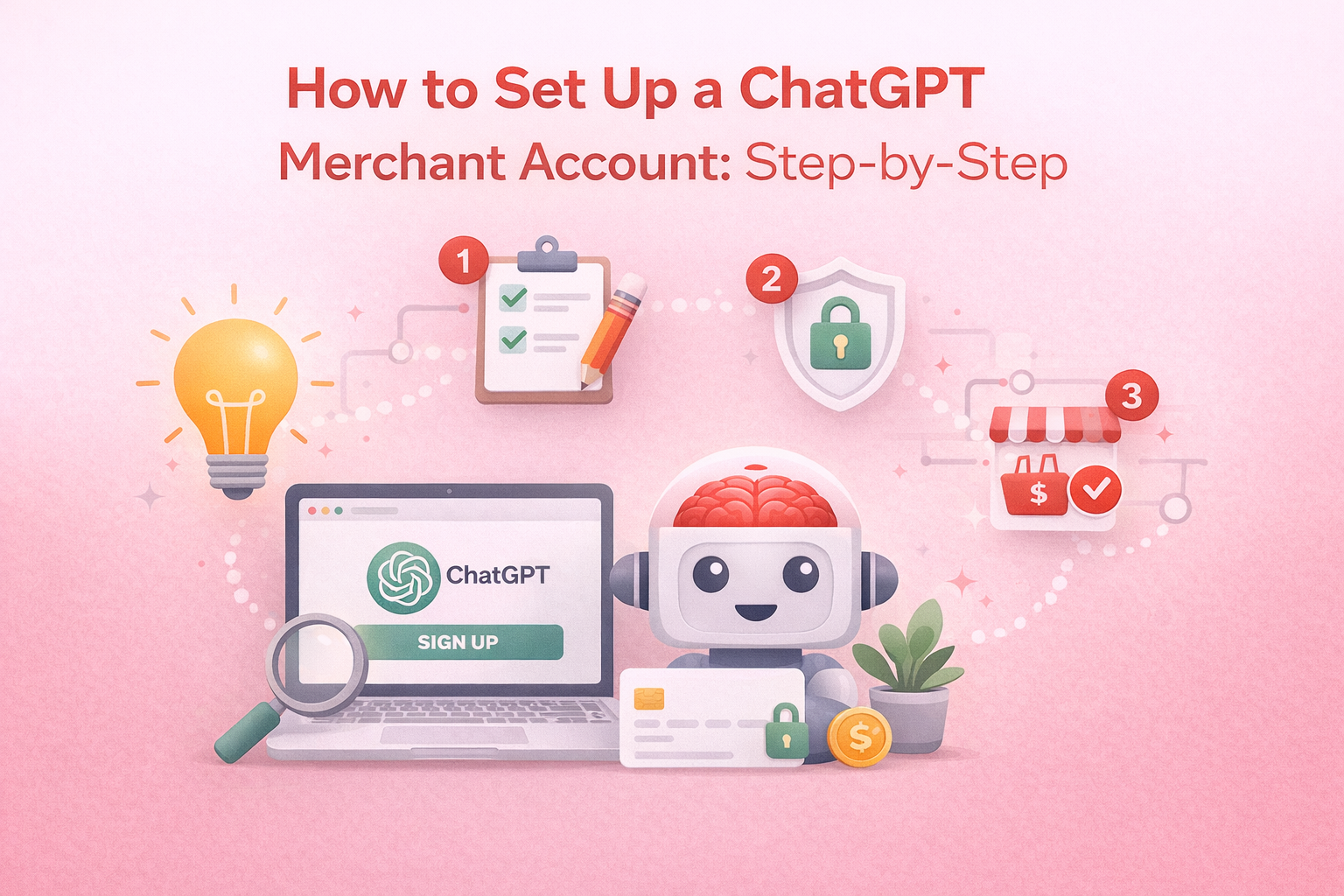ChatGPT now supports in-chat shopping via Instant Checkout, letting approved merchants list products that shoppers can buy directly inside a conversation while the merchant remains the merchant of record. This guide walks through eligibility, application, technical setup, and optimization so you can start selling in ChatGPT.
What ChatGPT Merchants Is
ChatGPT Merchants is OpenAI’s program that enables brands to surface products in ChatGPT and sell with Instant Checkout, powered by the open-source Agentic Commerce Protocol built with Stripe. It begins with Etsy sellers live and expands to Shopify merchants, with multi-item carts and more regions on the roadmap.
Instant Checkout handles a secure, tokenized handoff between buyer, ChatGPT, and your store; you keep your PSP, systems, and customer relationship while ChatGPT facilitates the transaction. OpenAI is not the merchant of record in this model.
Current Availability
At launch, in-chat purchases are available to U.S. ChatGPT users for single-item purchases, live with Etsy and rolling out to over 1M Shopify merchants next. Broader merchant categories, carts, and international expansion are planned as the program scales.
Before You Apply: Readiness Checklist
- Payments and tax: Confirm your PSP works smoothly today; you will continue charging through your existing processor under ACP.
- Shipping and returns: Ensure policies and logistics are clear; you will handle fulfillment and customer support.
- Product data quality: Prepare accurate, descriptive titles, rich descriptions, images, pricing, variants, and stock; product understanding drives organic recommendations.
Step 1: Apply at chatgpt.com/merchants
Visit the merchant application to provide business details, product categories, and whether you’ll use a platform integration (Etsy/Shopify) or a custom ACP integration. Approvals are rolling; expect a short review period once submitted.
What to have on hand:
- Legal business info and primary categories you sell.
- Your platform choice (Etsy, Shopify, or custom) and technical contact for integration.
Step 2: Choose Your Integration Path
- Etsy or Shopify: You’re eligible without heavy custom work; enable the official connection when available and keep product data synced.
- Custom stack (e.g., Magento, WooCommerce, bespoke): Implement ACP endpoints and connect your PSP using the Delegated Payment/Shared Payment Token approach. Community modules (e.g., Magento) can accelerate adoption.
Key principle: You stay in control of authorization, capture, taxes, refunds, and disputes via your existing PSP and order systems.
Step 3: Provide a Product Feed
Submit a structured product feed following OpenAI’s Product Feed Spec so ChatGPT can index and understand your catalog for relevant, organic results. Keep it fresh to reflect inventory, pricing, and variant availability.
Feed must include:
- Core fields: ID, title, description, price, images, category, availability.
- Variants and options: Sizes, colors, materials, and SKU-level stock.
Optimization tips:
- Use natural, conversational titles and descriptions that match shopper phrasing in chat.
- Include explicit personas, use cases, and constraints (e.g., “carry-on backpack under $100”) to help ranking and relevance.
Step 4: Implement Checkout (Custom Stacks)
If not on Etsy/Shopify, add ACP endpoints to create, confirm, and complete checkout sessions and to accept a delegated payment token for authorization and capture with your PSP. Stripe’s Shared Payment Token (SPT) is the first reference implementation and simplest path if you use Stripe.
Technical essentials:
- Checkout endpoints: Create/validate cart, calculate totals/tax, commit order, return status.
- Payments: Accept delegated token (e.g., Stripe SPT) and pass to your PSP for auth/capture; ChatGPT never handles raw card data.
Step 5: Configure Payments and Tax
Supported consumer methods include cards and wallets like Apple Pay, Google Pay, and Link by Stripe via your PSP integration, while you remain merchant of record. Ensure tax calculation and fraud tools are aligned with delegated tokens and your fulfillment geography.
Step 6: Test End-to-End
Run test orders through your ACP endpoints to verify:
- Product discovery: Correct titles, images, price, stock, and variants appear.
- Checkout: Address, shipping, tax, payment token, and order creation succeed without UI redirects.
- Post-purchase: Orders land in your OMS; emails, fulfillment, and returns workflows behave as expected.
Step 7: Go Live and Monitor
Once approved and verified, enable your catalog and monitor performance, disputes, and customer feedback. Keep your feed updated; stale data reduces visibility and may block checkout.
Fees and Economics
OpenAI charges a small transaction fee to merchants for completed purchases; the exact amount has not been disclosed publicly as of recent announcements. Plan for this fee alongside your standard PSP costs and any marketplace platform fees.
Growth and Optimization Tactics
- Rich context beats sparse data: Add persona hints, use cases, materials, fit notes, and comparisons to improve relevance.
- Keep prices and availability competitive: Relevance is organic; value and clarity drive inclusion and clicks.
- Maintain fresh feeds: Update imagery, pricing, and inventory at least daily—more frequently for fast-moving SKUs.
Roadmap and Partnerships
OpenAI is expanding merchants and regions, with Shopify support rolling out and a broader ecosystem via ACP, co-developed with Stripe and joined by payments partners like PayPal for discovery and processing reach. Expect multi-item carts and international availability as the program evolves.
Frequently Asked Questions
- Do shoppers see ads or paid placements? Results are organic and unsponsored at this stage; focus on quality data and relevance.
- Does ChatGPT hold my customer relationship? No—merchants keep payments, order management, service, and post-purchase relationships.
- Can non-Stripe PSPs work? Yes; ACP is payment-agnostic via delegated payment specs, though Stripe SPT is the fastest path today.
If you’re on Shopify or Etsy, enable the connection as it rolls out and focus on product data excellence; if you’re custom, plan a sprint to implement ACP endpoints and delegated payments so you can convert ChatGPT’s conversational demand into orders without leaving the chat.


